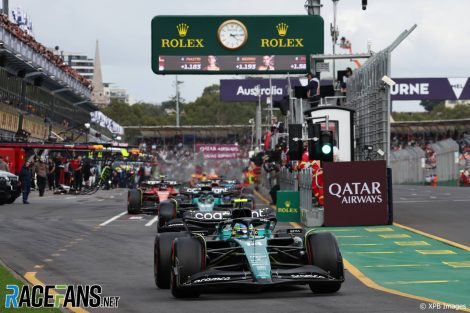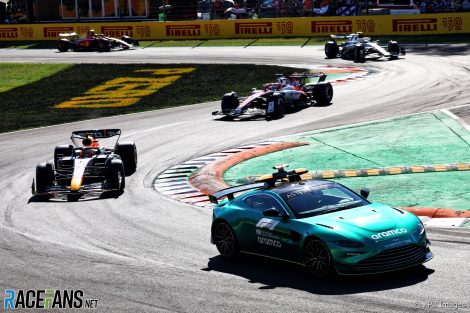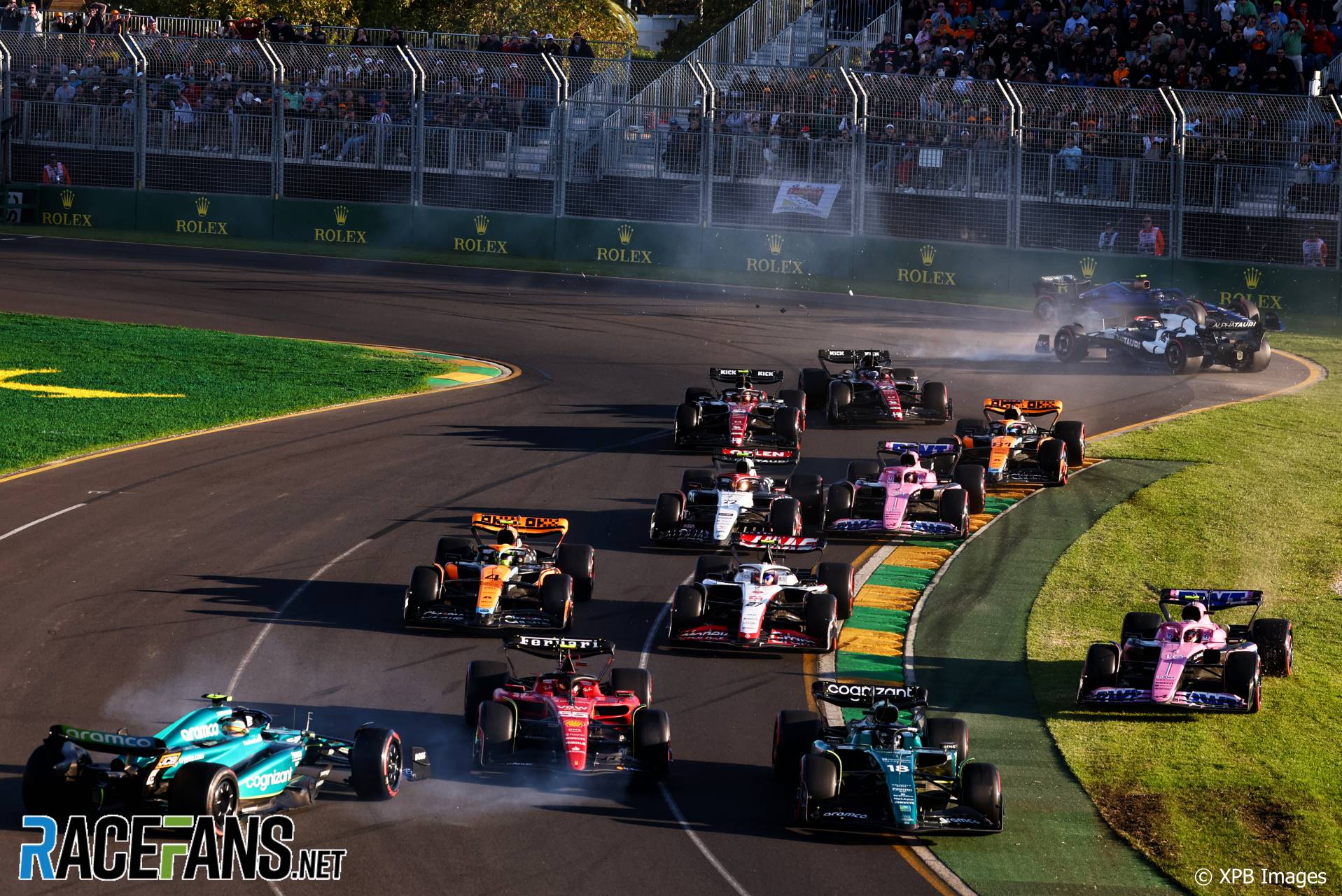Aston Martin has defended the FIA’s handling of the Australian Grand Prix following the controversial conclusion to the last round of the championship.
The race was red-flagged and restarted with two laps to go following Kevin Magnussen’s late retirement. Six drivers were involved in collisions at the standing restart, which led to a further red flag.Following a lengthy delay a final restart was called but with only one lap remaining all the drivers could do was follow the Safety Car without overtaking. Some criticised the final lap as unnecessary, while others argued it was inappropriate to use a standing restart so late in the race.
Both Aston Martin drivers lost places at the standing restart. Fernando Alonso was hit by Carlos Sainz Jnr, while Lance Stroll skidded off at turn four. However as the FIA subsequently chose to reset the running order to the positions drivers held at the previous start – another decision which attracted criticism – both drivers were restored to their positions.

“We had a conversation with race control before it all happened, to let them know what our understanding of the rules was, and they informed us of the decision they were going to make and that their interpretation of the rules was the same. There was a bit of uncertainty, but the FIA got it right.”
The FIA’s handling of late-race restarts has drawn criticism in recent years. A similar late standing restart was used at the Azerbaijan Grand Prix in 2021. But that year’s season finale ended in controversy when a rolling restart was used on the final tour without all drivers being allowed to re-join the lead lap – a rule-breaking call which influenced the outcome of the world championship.
Advert | Become a RaceFans supporter and
Last year’s Italian Grand Prix ended under Safety Car conditions due to a delay in the recovery of Daniel Ricciardo’s stricken McLaren, prompting some to ask why a standing restart was not used. Stevenson said the Australian Grand Prix showed the FIA has taken recent lessons on board.

“None of the people who were disagreeing with the red flag in Australia had all information about the condition of the safety barriers, what was happening around the circuit, and where the safety vehicles and doctors were. No one did, except the FIA. We have to trust the FIA because they have all the information.”
Stevenson feels the FIA “can never win” with decisions such as these. “When the race goes well it’s because everyone else was great and when it goes wrong it’s because the FIA got it wrong.
“I feel for them, but it goes with the territory – they take on that responsibility and they handle it very well.”
Two of Aston Martin’s rivals formally objected to decisions made during the Australian Grand Prix. Ferrari tried to force a review of Sainz’s penalty for colliding with Alonso, and Haas protested the result of the race by claiming the FIA failed to correctly establish the running order ahead of the final restart. Both attempts to alter the result were rejected.
Advert | Become a RaceFans supporter and
At the previous race in Saudi Arabia, Aston Martin successfully overturned a penalty Alonso had been given. Stevenson said pressing cases such as this are “when I thrive.”

“You can call on past experiences and precedents that have been set. Every off-season I watch replays of races – endlessly. It drives my wife crazy, but I do it to remind myself of what’s happened and the precedents that have been set so I can be prepared for the challenging moments we’ll inevitably face in the season ahead. And, obviously, I do a lot of preparation with the sporting regulations – you have to know them inside-out.”
“You’ve got to pick your fights,” he added. “You can’t always be in the ear of the FIA. Sometimes decisions won’t go in your favour, but you’ve got to roll with it.
“When it’s fairly clear-cut or something that you’re going to gain from, that’s when you go in to fight your corner. You need to have every shred of information that will support your case ready to present to the FIA.
“You can never appeal a decision on a whim. If you start crying wolf, the FIA will never listen to you.”
Advert | Become a RaceFans supporter and
2023 F1 season
- FIA president cleared of alleged interference in two 2023 races
- First week viewing figures for new Drive to Survive season fall again
- Max who? Drive to Survive season six prefers its favourite faces
- RaceFans’ complete 2023 season review
- The F1 drivers who pulled off the 10 biggest charges through the field in 2023





Red Andy (@red-andy)
21st April 2023, 7:31
They’ve certainly learned *something*, but I’m far from sure it’s the *right* thing.
CarWars (@maxv)
21st April 2023, 7:43
This wasn’t good for the show and a pointless restart.
CarWars (@maxv)
21st April 2023, 7:44
The last red flag that is. They did learn to throw yellows and red flag for every little cough a car makes.
Proesterchen_nli
21st April 2023, 7:49
Transparently self-serving comment.
Yawn.
Willie Dustice
21st April 2023, 8:02
learned what?
what a load of rubbish
MacLeod (@macleod)
21st April 2023, 8:03
As they don’t want to finish under yellow it was a understandable decision still it finished under yellow :)
I think a rolling start was a beter one with the low sun.
Jere (@jerejj)
21st April 2023, 8:04
Learned from the last few years? – Yeah, right.
Pedro (@)
21st April 2023, 20:45
+1
Simon
22nd April 2023, 16:13
@jerejj
https://media2.giphy.com/media/Qa97lmqC43yIyOEzwT/giphy.gif
SteveP
21st April 2023, 8:48
I seem to recall a lot of people round here saying that they should do it Indy car style and red flag for a restart.
What happened? did your favourite driver come out on the bad end of things?
Short Circuit (@jjohn)
21st April 2023, 9:39
Every start or restart should be a standing start. If that doesn’t spice up the show enough, there’s always the anti-stall that could be removed. Think how much safer turn 1 would be as the best 20 drivers in the world decimate half the field at or near the start/finish line!
Subjective stewards penalties could be considered while the debris is cleared.
Talking heads debating the cause of the carnage, all outdoing each other in quest of The Talking Head Of The Year gong!
Now THAT’S a show Liberty.
Jimmi Cynic (@jimmi-cynic)
21st April 2023, 10:24
Brilliant, @jjohn! F1: The Global Pinnacle of Hybrid Bumper Cars!
MacLeod (@macleod)
21st April 2023, 13:23
@jjohn As i said a rolling start was beter due the low standing of the sun that why i said that restart should be rolling instead of standing. Otherwise your right standing is beter.
Sham (@sham)
21st April 2023, 10:44
Since mid 21, when more and more decisions on on track incidents, penalties and the decisions around stoppages and safety cars became obviously about increasing the spectacle.. I’ve been more and more disinterested in F1 as a sport.
I do not believe that the current rules and governance provide a level playing field for all competitors – it’s better than the Bernie days, but the problems are more obvious when it’s down to on track decisions by the race director and not about funding and backhanders, etc.
Tristan (@skipgamer)
21st April 2023, 15:19
It was better, but it still wasn’t “right” the roll back of positions was the weirdest and most confusing part.
Pedro (@)
21st April 2023, 20:46
I think you’re missing a comma, or a dot and comma
Tristan (@skipgamer)
21st April 2023, 23:56
Guilty as charged
mrfill (@mrfill)
21st April 2023, 15:49
They may have learned to apply their rules strictly, regardless how daft those rules maybe…
Pedro (@)
21st April 2023, 20:47
Ha, ha, ha! How about nope
Stephen Crowsen (@drycrust)
21st April 2023, 22:09
One way children learn is by realising that certain actions have unpleasant consequences. Again we are talking about the race and not the result of it. I have complete faith that the claim this foolish way of concluding a race complies with the regulations is true. I guess the next question is could another race finish just as foolishly and ineptly or will the FIA know better next time? Unlike the vast majority of children, who learn from unpleasant experiences, the FIA appears to have no intention of changing the rules, and since we’re told the GP finished the only way it could have, then we have to conclude the next time there’s a Red Flag event at such a late stage in the race then we’re in for another fiasco finish.